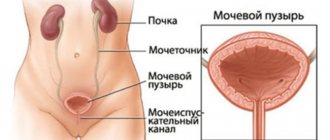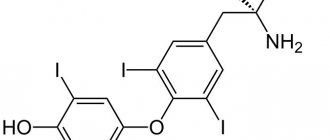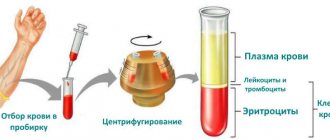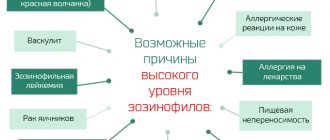The hormone estrogen, due to its wide spectrum of action (both positive and negative), has received a dual name among specialists -
“ angel of life, angel of death .
” Let's talk about its effect on the female body. The word “estrogen” itself is the name of not just one hormone, but a whole group of substances that have estrogen-like properties. These substances include: estrogens produced in the human body, animal estrogens, synthetic estrogens, phytoestrogens and xenoestrogens. Of all the types of estrogen produced in the human body, the main ones are estradiol, estrone and estriol.
Hormonal imbalance
In the female body, estrogen is produced mainly in the ovaries and plays a very important role in the development of primary and secondary sexual characteristics during puberty, and later in the normal functioning of the female reproductive system. Estrogen stimulates the growth of the endometrium of the uterus immediately after menstrual bleeding, preparing it for future pregnancy.
Female-type fat deposits (on the hips and chest) are also the work of the hormone estrogen. Estrogen has a stimulating effect on brain cells, improves memory, and prevents dementia. Most organs in our body have receptors sensitive to the action of estrogen: skin, lungs, gastrointestinal tract, cardiovascular system, musculoskeletal system, uterus, mammary glands. Estrogen makes a woman a woman: sexy and attractive.
When the body maintains a state of hormonal balance, each hormone performs its functions, ensuring the coordinated functioning of the whole organism as a whole. But from about 35 years of age, the female body begins to experience fluctuations in the production of hormones such as estrogen and progesterone (the hormone that balances estrogen). This stage is called perimenopause. From this time until the onset of menopause, the synthesis of the hormone estrogen gradually decreases by an average of 25–30%. At the same time, progesterone synthesis drops sharply by an average of 70–75%. Because of this difference in estrogen and progesterone production, maintaining normal estrogen levels in women becomes increasingly difficult. It is at this time that most of us begin to experience (to a greater or lesser extent) various problems with the menstrual cycle, sudden mood swings, headaches, decreased libido, unexplained fatigue, weight gain. These are symptoms of estrogen dominance.
Reasons for increased indicators
Certain factors contribute to an increase in estrogen in women:
- early onset of menstruation (up to 7 years),
- pregnancy, during which additional production of hormones occurs by the placenta,
- improper diet, consumption of genetically modified foods that affect hormonal synthesis,
- deficiency of vitamins and minerals, in particular folic acid, selenium, retinol,
- an unbalanced system of physical activity, this can be either physical inactivity or excessive passion for sports,
- consumption of alcohol and cigarettes,
- taking oral contraceptives, which help increase the concentration of estrogen,
- frequent stressful conditions.
Among the pathological conditions affecting hormonal levels are:
- ovarian cyst,
- cancer,
- pituitary adenoma,
- disruption of the adrenal glands.
Reference! Most women whose body weight is 20% higher than normal have elevated estrogen levels.
https://youtu.be/K08eMYPcei4
Estrogen dominance
Let's find out why our bodies produce excess estrogen, what happens as a result of its accumulation, and how we can help our body prevent it. The answer to this question is fundamental to maintaining hormonal balance, and therefore maintaining excellent health.
Estrogen dominance is a condition characterized by excess estrogen in the body, which leads to numerous negative effects. It is important to understand that estrogen dominance can be caused not only by increased levels of estrogen itself, but also by decreased levels of progesterone, a hormone that works in tandem with estrogen.
The problem of estrogen dominance is greatly exacerbated in premenopausal women due to a lack of ovulation. During ovulation, the egg leaves the follicle in the ovary. This follicle degenerates into the corpus luteum and begins to synthesize progesterone. But if there is no ovulation, then there is no corpus luteum and progesterone. As a result, a woman can continue to have a normal menstrual period, but a lack of progesterone provokes premenstrual syndrome in her: breast tenderness, fluid retention in the body, pain in the lower abdomen, irritability, weight gain.
Excess estrogen leads to numerous pathological conditions in our body, most of which are accompanied by stimulation of cell growth, as this is the main function of estrogen in the body.
Estrogen stimulates the cells of organs that have receptors for estrogen to their rapid growth, leading to the formation of benign and malignant formations: uterine fibroadenoma, cysts in the ovaries, fibrocystic formations in the mammary glands, breast cancer, endometriosis, uterine bleeding.
Additionally, excess estrogen can cause bloating and increase blood pressure due to sodium and water retention in the body. Due to its stimulating effect on the central nervous system, excess estrogen makes us irritable, causes headaches and disrupts sleep.
Estrogen increases the release of histamine and, as a result, an increased tendency to allergic reactions and all kinds of inflammation may develop.
Estrogen dominance increases insulin levels, which in turn lowers blood sugar and causes increased appetite and sugar cravings, leading to overeating and gaining extra pounds.
As you know, in order to solve a problem, it is necessary, firstly, to identify it; secondly, eliminate the causes that give rise to it; and thirdly, take preventive measures.
The role of estrogen in the female body
Estrogens affect heart rate, are responsible for reproductive functions and normal childbearing, and also affect a woman’s appearance. Hormones are necessary for the cyclic renewal of endometrial cells in the uterus, its growth and rejection during menstrual bleeding, they regulate fat and water-salt metabolism.
How does estrogen affect women's appearance and health:
- the skin is smooth, elastic, without acne and other rashes, the complexion is healthy;
- narrow waist, steep hips;
- large breasts;
- the voice is deep, with velvety notes;
- strong bones and teeth, good condition of muscle tissue;
- good performance, stress resistance.
The maximum level of estrogen is observed when ovulation approaches - the hormone synthesizes special pheromones that attract men, on such days a woman becomes very sexy. Hormones affect blood clotting, so when they are deficient, periods become heavy and prolonged.
Note! Mood swings before menstruation are the first sign of estrogen deficiency.
Causes of estrogen dominance
Liver overload
Excess estrogen is eliminated by the liver. If the liver is overloaded with toxins from food, such as artificial additives and colors, preservatives, trans fats, oxidized fatty acids, metabolic products of drugs and alcohol, then the cleansing process is significantly slowed down, and excess estrogen accumulates in the body in a more toxic form (estrone and estradiol). ). It is these forms of estrogen that can cause breast and endometrial cancer.
· Intestinal problems
Constipation slows the transit of contents through the intestines and increases the time for reabsorption of estrogen metabolites. Unbound estrogens are reabsorbed into the blood and begin to circulate in the body again, exacerbating hormonal imbalances.
· Lack of sleep
A lack of nighttime sleep sharply reduces the amount of melatonin, the pineal gland hormone responsible for normal sleep. Since melatonin balances estrogen, decreasing its amount leads to an increase in circulating estrogen. Insomnia, shallow, intermittent, short night sleep deplete the adrenal glands and stimulate the release of cortisol, the main stress hormone. Cortisol and progesterone share the same metabolic pathway. Excess cortisol literally steals progesterone from the body, leading to even greater imbalance.
· Excess weight
In addition, cortisol stimulates the production of insulin, another hormone responsible for the accumulation of extra pounds. The combination of a sedentary lifestyle and extra pounds increases the likelihood of estrogen dominance. Adipose tissue accumulates various toxins, which begin to circulate in the blood, overloading the detoxification work of the liver. Toxins stored in fat tissue also stimulate the synthesis of even more estrogen.
Xenoestrogens
Xenoestrogens are substances foreign to the body that mimic the action of estrogen. Most people living in developed societies experience minor symptoms of estrogen dominance. The reason for this is scientific and technological progress and xenoestrogens that surround us everywhere. Only by being in an isolated cocoon can you avoid exposure to industrial waste, plastic, petroleum products, pesticides, cosmetics, disinfectants, and household products (linoleum, carpeting, paint). Once in the body, some xenoestrogens stimulate the synthesis of estrogens in the body, while others precisely fit into the estrogen receptors of cells, like a key to a lock, and give the cell a command to act (for example, they stimulate tumor growth). Tap water in most communities is also a source of estrogen due to the large number of women receiving hormone replacement therapy and taking birth control pills. All pharmacological drugs are metabolized in the liver, and their metabolites are excreted from the body naturally. Municipal water treatment plants are unable to filter pharmacological metabolites and hormones. As a result, estrogens again enter the water, and from there into our food.
For what symptoms should treatment be started?
The above symptoms do not always indicate the presence of estrogen deficiency. Similar symptoms can be encountered with other diseases. However, the first thing that should alert a woman is disruption of the menstrual cycle. In this condition, in any case, it is necessary to contact a gynecologist.
If a woman experiences several symptoms of estrogen deficiency at once, then this manifestation cannot be ignored. When visiting a medical facility, the doctor will definitely prescribe a blood test to determine the quantitative content of hormones in the body. Sometimes, in addition to this diagnostic measure, urine and follicle-stimulating hormone tests are prescribed.
https://youtu.be/B99sZpW9rAc
How to prevent estrogen dominance
What to do to prevent estrogen dominance and the development of pathological conditions that can provoke cancer and other diseases:
· Have fasting days regularly
Try to eat organic, freshly prepared foods. Alternate taking herbal infusions of dandelion root, milk thistle, and medicinal burdock to normalize liver function and cleanse the gastrointestinal tract. Take fermented milk products or probiotics daily to maintain healthy gut flora.
Drink only filtered water and use only glass containers for food and water
Most plastic products literally impregnate our food with various chemical compounds, especially when heated repeatedly. One of them is bisphenol A, a substance that, once in the body, mimics the effects of estrogen.
· Control the level of stress in your life
The combination of stress and estrogen dominance creates a vicious cycle: stress (that is, cortisol) leads to estrogen dominance, which in turn causes sleep disturbances, constant worry and worry, and ultimately leads to adrenal fatigue. A woman who finds herself in this circle is usually constantly tense - she seems to be filled with uncontrollable energy, but at the same time she constantly feels tired. Exercise regularly, do yoga, and visit the sauna. Get at least eight to nine hours of sleep every day.
· Drink dietary supplements
Add dietary supplements to your diet that weaken the stimulating effect of excess estrogen: iodine, vitamin E, folic acid, vitamin B6, magnesium, fish oil. If there are no contraindications, use flax oil and evening primrose oil alternately to harmonize the functioning of female hormones during the menstrual cycle. Flax oil - from the 1st to the 14th day of the cycle to support estrogen function; evening primrose oil - from the 15th to the 28th (30th) day of the cycle (before the onset of menstruation) to maintain progesterone function.
Lack of estrogen in women - treatment
Treatment for estrogen deficiency depends on the cause. Having determined the lack of estrogen, treatment is prescribed individually. As a rule, treatment is carried out with drugs or tablets. But you can also add foods that contain estrogens to your diet. Young women with symptoms of a lack of the female hormone estrogen are not treated the same as older women with low estrogen levels during menopause. In all cases, specific treatment is determined by the underlying cause.
In this article, we looked at what estrogens are, female hormones - symptoms of their deficiency in women during menopause and in young women.
Receive new articles by email











